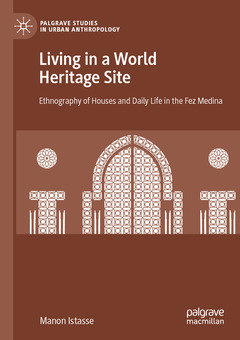Description
Living in a World Heritage Site, 1st ed. 2019
Ethnography of Houses and Daily Life in the Fez Medina
Palgrave Studies in Urban Anthropology Series
Author: Istasse Manon
Language: English
Subjects for Living in a World Heritage Site:
Approximative price 52.74 €
In Print (Delivery period: 15 days).
Add to cartPublication date: 08-2020
Support: Print on demand
Publication date: 07-2019
293 p. · 14.8x21 cm · Hardback
Description
/li>Contents
/li>Biography
/li>Comment
/li>
Through a thick ethnography of the Fez medina in Morocco, a World Heritage site since 1981, Manon Istasse interrogates how human beings come to define houses as heritage. Istasse interrogates how heritage appears (or not) when inhabitants undertake construction and restoration projects in their homes, furnish and decorate their spaces, talk about their affective and sensual relations with houses, face conflicts in and about their houses, and more. Shedding light on the continuum between houses-as-dwellings and houses-as-heritage, the author establishes heritage as a trajectory: heritage as a quality results from a ?surplus of attention? and relates to nostalgia or to a feeling of threat, loss, and disappearance; to values related to purity, materiality, and time; and to actions of preservation and transmission. Living in a World Heritage site provides a grammar of heritage that will allow scholars to question key notions of temporality and nostalgia, the idea of culture, theimportance of experts, and moral principles in relation to heritage sites around the globe.
Acknowledgements.- List of Abbreviations.- List of Pictures.- Chapter 1: Introduction.-Chapter 2: Fez.- Part I: Houses in Fez: A Materialist Approach.- Chapter 3: Undertaking Work in a House.- Chapter 4: Furnishing and Decorating a House.- Chapter 5: Intimacy, Hospitality and Tradition in Tourist Accommodation.- Part II: Attachment to Houses: Home and Heritage.- Chapter 6: Sensual, Affective, and Cognitive Relations with Houses.- Chapter 7: From Conflicts to the Attachment to Houses.- Part III: Heritage in Fez.- Chapter 8: Heritage: Forms, Grammar, and Circulation.- Chapter 9: Conclusion.- Glossary.- Index.
Manon Istasse is a Postdoctoral Researcher at the Laboratoire d’Anthropologie de Mondes Contemporains (LAMC) at Université Libre de Bruxelles, Belgium.



